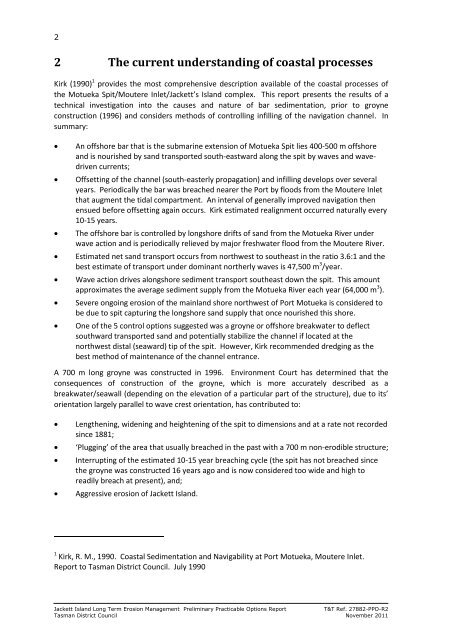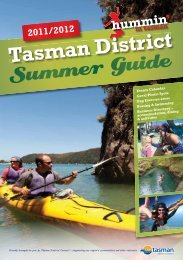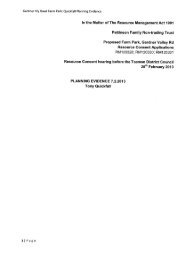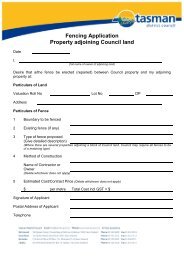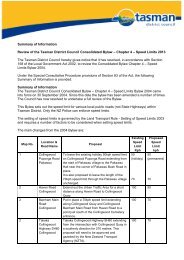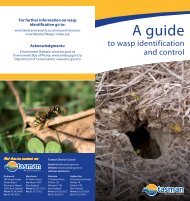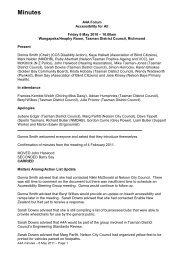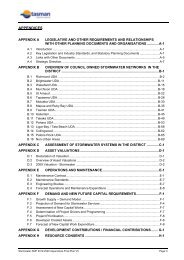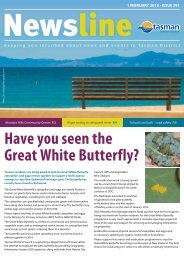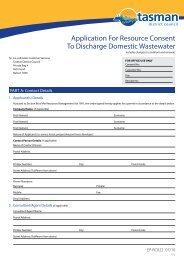RESC11-12-02 Port Motueka Groyne-Jackett Island Erosion ...
RESC11-12-02 Port Motueka Groyne-Jackett Island Erosion ...
RESC11-12-02 Port Motueka Groyne-Jackett Island Erosion ...
Create successful ePaper yourself
Turn your PDF publications into a flip-book with our unique Google optimized e-Paper software.
2<br />
2 The current understanding of coastal processes<br />
Kirk (1990) 1 provides the most comprehensive description available of the coastal processes of<br />
the <strong>Motueka</strong> Spit/Moutere Inlet/<strong>Jackett</strong>’s <strong>Island</strong> complex. This report presents the results of a<br />
technical investigation into the causes and nature of bar sedimentation, prior to groyne<br />
construction (1996) and considers methods of controlling infilling of the navigation channel. In<br />
summary:<br />
<br />
<br />
<br />
<br />
<br />
<br />
<br />
An offshore bar that is the submarine extension of <strong>Motueka</strong> Spit lies 400-500 m offshore<br />
and is nourished by sand transported south-eastward along the spit by waves and wavedriven<br />
currents;<br />
Offsetting of the channel (south-easterly propagation) and infilling develops over several<br />
years. Periodically the bar was breached nearer the <strong>Port</strong> by floods from the Moutere Inlet<br />
that augment the tidal compartment. An interval of generally improved navigation then<br />
ensued before offsetting again occurs. Kirk estimated realignment occurred naturally every<br />
10-15 years.<br />
The offshore bar is controlled by longshore drifts of sand from the <strong>Motueka</strong> River under<br />
wave action and is periodically relieved by major freshwater flood from the Moutere River.<br />
Estimated net sand transport occurs from northwest to southeast in the ratio 3.6:1 and the<br />
best estimate of transport under dominant northerly waves is 47,500 m 3 /year.<br />
Wave action drives alongshore sediment transport southeast down the spit. This amount<br />
approximates the average sediment supply from the <strong>Motueka</strong> River each year (64,000 m 3 ).<br />
Severe ongoing erosion of the mainland shore northwest of <strong>Port</strong> <strong>Motueka</strong> is considered to<br />
be due to spit capturing the longshore sand supply that once nourished this shore.<br />
One of the 5 control options suggested was a groyne or offshore breakwater to deflect<br />
southward transported sand and potentially stabilize the channel if located at the<br />
northwest distal (seaward) tip of the spit. However, Kirk recommended dredging as the<br />
best method of maintenance of the channel entrance.<br />
A 700 m long groyne was constructed in 1996. Environment Court has determined that the<br />
consequences of construction of the groyne, which is more accurately described as a<br />
breakwater/seawall (depending on the elevation of a particular part of the structure), due to its’<br />
orientation largely parallel to wave crest orientation, has contributed to:<br />
<br />
<br />
<br />
<br />
Lengthening, widening and heightening of the spit to dimensions and at a rate not recorded<br />
since 1881;<br />
‘Plugging’ of the area that usually breached in the past with a 700 m non-erodible structure;<br />
Interrupting of the estimated 10-15 year breaching cycle (the spit has not breached since<br />
the groyne was constructed 16 years ago and is now considered too wide and high to<br />
readily breach at present), and;<br />
Aggressive erosion of <strong>Jackett</strong> <strong>Island</strong>.<br />
1 Kirk, R. M., 1990. Coastal Sedimentation and Navigability at <strong>Port</strong> <strong>Motueka</strong>, Moutere Inlet.<br />
Report to Tasman District Council. July 1990<br />
<strong>Jackett</strong> <strong>Island</strong> Long Term <strong>Erosion</strong> Management Preliminary Practicable Options Report<br />
T&T Ref. 27882-PPO-R2<br />
Tasman District Council November 2011


